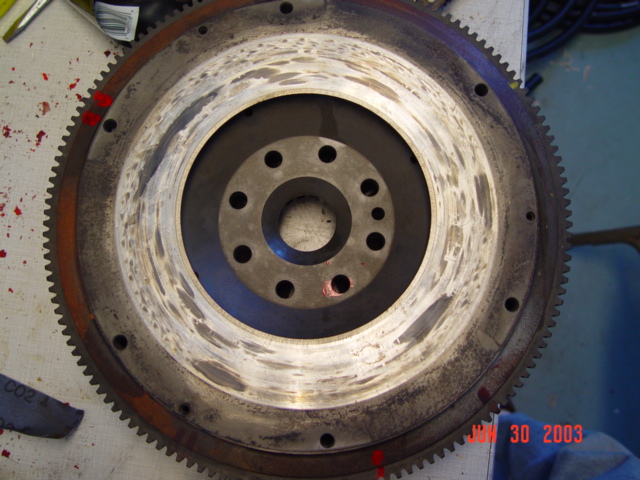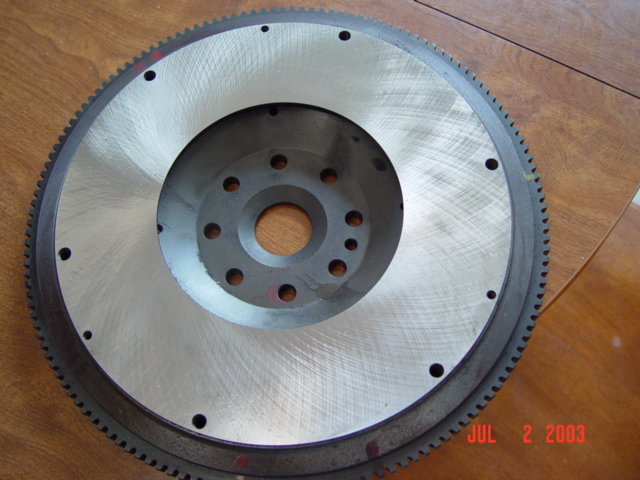| Author | Message | ||
| Henryk (Henryk)
Member Username: Henryk Post Number: 869 Registered: 8-2001 |
FYI: Weight of the "new" clutch = 16.83 lbs. Weight of the "original" clutch = 15.73lbs. | ||
| DaveE (Banzaiboxr)
Junior Member Username: Banzaiboxr Post Number: 157 Registered: 8-2002 |
Henry and David , Thanks for the input .I may replace the clutch pending on the mechanics advice.The snout you are refering to is the problem and will need to be replaced. | ||
| David Feinberg (Fastradio2)
Junior Member Username: Fastradio2 Post Number: 239 Registered: 4-2002 |
Dave, To answer some of your questions: Resurfacing the flywheel: $50-$80 max to grind properly. The fine cross-hatching pattern on Henrys' is what you should end up with. The binding (area) that the dealer is referring to is the "snout" that the TO beaing collar slides on. This is the piece that extends from the bell housing. (There is an oil seal and on some BB models an o-ring, as well, which keeps trany oil out of the bellhousing.) The snout doesn't bend, per se...but rather develops a wear pattern which causes some resistance as the TO bearing is engaged/disengaged. The TO bearing/collar assembly should slide very smoothly on the snout (with a light application of moly grease.) Quite a few years ago, I did replace this part on my BB... Regards, David | ||
| Henryk (Henryk)
Member Username: Henryk Post Number: 867 Registered: 8-2001 |
Dave: Are you getting a new clutch? No point in re-surfacing the flywheel if the clutch isn't replaced. My clutch was NOT very heavy. | ||
| Henryk (Henryk)
Member Username: Henryk Post Number: 866 Registered: 8-2001 |
Dave: I don't know the cost of re-surfacing the flywheel......mine was done in school.....I take evening machine shop class as a hobby. What shaft are you referring to? The heavyness of a clutch is usually always due to the tightness of the pressure plate fingers. | ||
| DaveE (Banzaiboxr)
Junior Member Username: Banzaiboxr Post Number: 156 Registered: 8-2002 |
Great information! My BBi is in for a Major and wanted to know what the price is for resurfacing the flywheel. Also my clutch is very heavy too push and was told that the Bearing ? or shaft - sleeve? might have a kink in it from wear.I know clutches in these cars are typicaly heavy but anyone replace that shaft? and is it easy to replace or fix? | ||
| peter brinzey (Ferraripete)
Junior Member Username: Ferraripete Post Number: 75 Registered: 11-2002 |
david, i know that you are a friend of paul and lauren fix. i think i had heard that george had passed away. it that true? is ssbc still in bussiness? what ever happened to his bbi? | ||
| David Feinberg (Fastradio2)
Junior Member Username: Fastradio2 Post Number: 237 Registered: 4-2002 |
Henry, FYI, I had the same shaft binding issue with my BB. Tough to get the pins out...but a little drilling and tapping, and out they came. The pins are readily available from Ferrari (PN 106686). A little hone and moly grease and she's better than new. The thickness of the new flywheel (not height) is 20.25mm, as measured from the friction surface to the machined surface below the ring gear. With that dimension in mind as the "new" reference, I believe Ferrari gives us 1mm for re-surfacing... Regards, David | ||
| peter brinzey (Ferraripete)
Junior Member Username: Ferraripete Post Number: 74 Registered: 11-2002 |
guys, i have made a few calls to the shop working on my boxer...we will resurface the clutch. is there aminimum thickness that should be observed? my car only has 18,000 km and as such, has not been cut previously. a note to jrv...i have tried to keep you up to date and have called on you for advice on the mainshaft issue, so here is an update. i look forward to you response. it looks like the mainshaft (male part) was not held in place tightly and it seemed the fastner that holds it in place was loose. this looseness allowed the shaft to have some runout and where it slides into the female part was where the shaft actually was sheared. That point being the most secure area would also seem the the area where breakage would seem most logical based on the dynamic of the rotation. when i finally get my boxer back...it will be like driving a new car. not because of the repairs, but because i have not driven it for sooooo looooong! | ||
| JRV (Jrvall)
Intermediate Member Username: Jrvall Post Number: 1841 Registered: 11-2002 |
The original thickness is easy to note by looking at the timing marks and the outer area where the PP bolts up. | ||
| Henryk (Henryk)
Member Username: Henryk Post Number: 844 Registered: 8-2001 |
Peter: While you are at it, definitely check out the bearings and shaft holding the fork that pushes the throw-out bearing. I just worked on mine.......the shaft was very stiff. It should be very loose.......if not, then it may hold the throw-out bearing constantly against the clutch fingers....wearing out both prematurely. I couldn't get the two pins out that hold the fork onto the shaft. Had to grind them down and drill them out. None of the 3 bearings where very loose.....the cover bearing didn't move at all. I am soaking them in solvent overnight. Will see if they are free, then lube them up with a graphite grease. I will polish the bearing surfaces on the shaft.......hope it works. This is another one of those repairs that I don't here much of.......maybe the service guy just doesn't want to go to the trouble of drilling, etc. Two new pins will have to be machined. Good luck. What have you decided on the flywheel? | ||
| James Selevan (Jselevan)
Member Username: Jselevan Post Number: 628 Registered: 6-2002 |
David - that would be a great help. This is a potential resource (new flywheel dimensions) that will live forever in the annals of "Unimportant data until you need the data." These dimensions will be printed and inserted in the workshop manual. Might you hand-draw a picture revealing the dimensions you measure? Thank you. Jim S. | ||
| David Feinberg (Fastradio2)
Junior Member Username: Fastradio2 Post Number: 236 Registered: 4-2002 |
Yes... I have a brand new BB flywheel in hand. Recently puchased from my new buddies at Ferrari UK. I'll measure her up and post the thickness shortly. As to Peter's comments and concern: If the flywheel is even moderately discolored, even in just one or two spots....a clean-up is worthwhile. Often clutch chatter and pre-mature wear can be attributed to (starting off with) an irregular flywheel surface... Regards to all, David | ||
| Henryk (Henryk)
Member Username: Henryk Post Number: 842 Registered: 8-2001 |
Measuring flywheel thickness: If you will look at the 7 o'clock position of the resurfaced flywheel, you will notice a small drop-off.....this goes around the whole flywheel.....it is a lip around 1/16 inch wide. I used a depth gauge and measured 0.088 inch, from the surface to this lip. Add 0.012 (the amount ground down), and one gets 0.100 depth. Another method would be to lay flat the flywheel, on a precision granite slab, and measure the depth from the surface of the flywheel down to the granite. Either of these would be good reference points. However one would have to do this with a known new flywheel to be sure. | ||
| Henryk (Henryk)
Member Username: Henryk Post Number: 841 Registered: 8-2001 |
Frank: Re original thickness of flywheel, I did make an assumption. However, if you look closely at the before picture, there is a inner ring, about 1/8 inch wide......just inside where the disc would touch. This was slightly beveled, inward, with machining marks going inward, not circular. This narrow ring is GONE after I ground down the flywheel. This may be some sort of guide, as to whether the flywheel was ground......makes sense to me. Also, when closely observing the outer dark area.....just outside of where the disc touches (about 1 inch wide), there are no marks suggesting a previous grinding. I could be wrong, but that was my impression. BTW: I ended up grinding 0.012 inches, not 0.014. | ||
| James Selevan (Jselevan)
Member Username: Jselevan Post Number: 627 Registered: 6-2002 |
Frank - very important point. There is no mention, nor published specification in the WSM of the original (new) flywheel thickness. Thus, when removing the 1mm max, what is your baseline. When I remove my flywheel, I will measure the thickness. However, I believe the clutch has been changed once. Consequently, there is some likelihood that the flywheel has already been resurfaced. Anyone have a "virgin" flywheel we can measure? Jim S. | ||
| Frank R. Masiarz (Fmasiarz)
New member Username: Fmasiarz Post Number: 25 Registered: 9-2002 |
Hi...... The Ferrari workshop/repair manual for the Boxer states that maximum wear on the flywheel should not exceed 1 millimeter or 0.39 inch and it should have a surface microfinish of 0.8 micron. Always a good idea to mate a brand new clutch disc to a "fresh" flywheel surface..."just like new". Make sure that the pilot and throw-out bearings are in perfect condition as well. How does one know how many times a flywheel has been machined during its lifetime ? See no mention in the manual of "original thickness" or how one would measure the thickness...a reference point on the backside ?? Frank......23005 www.masiarz.net/bb_resource | ||
| Henryk (Henryk)
Member Username: Henryk Post Number: 840 Registered: 8-2001 |
Peter: Check the flywheel. If there are surface cracks, or dark spots, as on the before picture, then YES! Why ruin a new clutch, or, at the least, shorten it's life. The high and low spots where VERY obvious, but only observed during the grinding process. How can a clutch wear out, without scoring the flywheel? Maybe they just don't want to do it. Not all machine shops have the special grinder to do this......it would take time, that they may not want to spend. | ||
| peter brinzey (Ferraripete)
Junior Member Username: Ferraripete Post Number: 73 Registered: 11-2002 |
my car is getting a new clutch as we speak. i asked if the flywheel needed to be re -surfaced? i was told it was fine. will there be vibration as i ease the car off the line if i don't resurface? | ||
| James Glickenhaus (Napolis)
Intermediate Member Username: Napolis Post Number: 1905 Registered: 10-2002 |
Nice! | ||
| Henryk (Henryk)
Member Username: Henryk Post Number: 839 Registered: 8-2001 |
In preparation of installing a new clutch, I decided to re-surface the flywheel. I took it to my machine shop class for the re-grinding. I have heard that some people don't find this necessary. However, after seeing the high and low spots appear and disappear while grinding, I am glad I did it. The TR manual states a maximum wear of 1 mm(about 0.040 inch)......I will assume this is also true for the Boxer. Previous machining marks reveal that the Boxer flywheel was never re-surfaced before. The "before" picture was taken after the flywheel was totally cleaned with solvent. Before: There where burn marks, with some shiny surface showing, and a slight feel noticed with finger touch. There where numerous surface cracks throughout. After: I ended up taking off 0.014 inch in thickness......NO surface cracks. There where several high and low spots......all gone after re-grinding. I just thought I would share this with those interested. Conclusion: NEVER replace the clutch, without first re-grinding the flywheel.   |